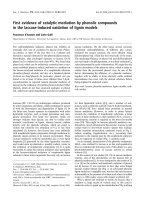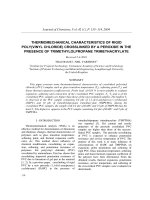Constraints experienced by tribal farmers in the information management
Bạn đang xem bản rút gọn của tài liệu. Xem và tải ngay bản đầy đủ của tài liệu tại đây (194.36 KB, 4 trang )
Int.J.Curr.Microbiol.App.Sci (2018) 7(3): 1230-1233
International Journal of Current Microbiology and Applied Sciences
ISSN: 2319-7706 Volume 7 Number 03 (2018)
Journal homepage:
Original Research Article
/>
Constraints Experienced by Tribal Farmers in the
Information Management
K. Naresh* and R.D. Ahire
Department of Extension Education, Vasantrao Naik Marathwada Krishi Vidyapeeth,
Parbhani – 431 402 (M.S.), India
*Corresponding author
ABSTRACT
Keywords
Constraints,
Knowledge and
Technology
Article Info
Accepted:
10 February 2018
Available Online:
10 March 2018
Total of 120 respondents were selected as sample respondents for this study. The present
study was conducted purposively in selected Kinwat and Mahur tahsil of Nanded district
as Kinwat taluka having highest tribal population in Marathwada region. Data were
collected through personal interview schedule. Results on the information management
behavior of tribal farmers revealed that majority of respondents on Information
Management Behaviour (82.50%) were grouped under medium category followed by low
(10.83%) and high (06.66%) categories and information acquisition behaviour indicates
that majority of respondents grouped under medium category (80.00 %) followed by low
(15.83 %) category. The major constraints identified by The tribal farmers in information
management behaviour indicates that ‘lack of knowledge on various information
evaluation methods’, was emerged as the major constraint followed by ‘lack of sufficient
tours and field trips for the farmers’, ‘ lack of time and mobility to meet scientists and
extensionists’, ‘lack of sufficient training programmes’.
Introduction
Now days, information is a basic necessity of
everyday life. For anything and everything
information is required. Information can be
obtained or retrieved from a variety of
sources. Farmers constitute a particular group
of users whose information needs is very
specific. The present paper deals with the
information needs of the farmer community in
rural areas. Agricultural Information System
(AIS) is a system in which agricultural
information is generated, consolidated,
received and feed back in such a manner that
these processes function synergistically to
understand
knowledge
utilization
by
agricultural producers (Rolling, 1988). The
present paper deals with the information needs
of the farmer community in rural areas. The
study conducted through survey method and
reveals that (40.58%) farmers require daily
information for various agriculture works.
Maharashtra state comprises 35 districts which
are grouped into six divisions for
administrative purpose. As per the 2011
census, Maharashtra has a population of
112,372,972 registering a population density
of 365per sq. kms. Out of the total population
males constitute 58.3millions and females
constitute 54.0 millions. The population in
1230
Int.J.Curr.Microbiol.App.Sci (2018) 7(3): 1230-1233
Nanded district is 33, 61,292 as per census
2011of which tribal population is 2, 81,695
respectively. Therefore, there is a need to
know the behaviour of farmers on
management
of
agricultural
related
information. Hitherto no such attempt was
made in this direction. However it is observed
that ‘lack of sufficient tours and field trips for
the farmers’, ‘ lack of time and mobility to
meet scientists and extensionists’, ‘lack of
sufficient training programmes’ Therefore,
study was conducted to identify the constraints
faced by tribal farmers in the information
management.
Materials and Methods
The present study conducted during 2015-16
year in Marathwada region as considerable are
under where maximum tribal population. In
Marathwada region one district namely
Nanded are selected purposively for the study.
From these districts ten villages selected that
is five villages from each tahsil were selected
purposively for study. From Mahur tahsil two
tahsil selected that is ten villages were
selected purposively from Kinwat and Mahur
tahsil Mahur, Kupti, Vanula, Pachunda,
Sakhur and from Kinwat tahsil Gokunda,
Bodhadi, Chikhali, Mohapur, Malborgaon
were selected as considerable area under
maximum population of tribal people from
each village twelve respondents were select
randomly from each village to comprise the
sample of 120 respondents for study. The data
from the respondents were collected through
personal interview schedule. The collected
data was analyzed with the help of suitable
statistical methods i.e. percentage, frequency
and mean.
Information acquisition behaviour
The distribution of respondents on information
acquisition behaviour indicates that majority
of respondents grouped under medium
category (80.00 %) followed by low (15.83 %)
category.
This finding is inline with the results of
Amtulwaris (2004).
Information processing behaviour
The distribution of respondents on information
processing behaviour indicates that majority
of them grouped under medium category
(82.50%).
Followed by low category (10.00 %) this
indicates that the farmers are not well aware
on various techniques of information
processing like information evaluation
treatment and storage.
These results are in conformity with the
findings of Ravindra et al., (2009).
Information dissemination behaviour
The distribution of respondents on information
dissemination behaviour shows that majority
of respondents (80.00%) were grouped under
medium category followed by low (11.66 %).
The lack of understanding on power of various
tools and techniques / methods in sharing the
information with other farmers could be the
reason for falling under medium followed by
low categories.
Results and Discussion
This finding is inline with the results of
Shanmuga and kangasabapathi (2008).
Information management behaviour has been
depicted in Table 1 and relevant discussions
have been summarized under following heads:
The constraints identified by the farmers in
their Information Management Behaviour are
shown in the Table 2.
1231
Int.J.Curr.Microbiol.App.Sci (2018) 7(3): 1230-1233
Table.1 Information management behavior of tribal farmers
1.Distribution of respondents with regard to their information acquisition behaviour
Sr.No. Category
Frequency
Percentage
Low
19
15.83
1
Medium
96
80.10
2
High
5
04.17
3
2.Distribution of respondents with regard to their information processing behaviour
Sr.No.
Category
Frequency
Per cent
Low
12
10.00
1
Medium
99
82.50
2
High
9
07.50
3
3.Distribution of respondents with regard to their information dissemination behaviour
Sr.No. Category
Frequency
Per cent
Low
14
11.66
1
Medium
96
80.00
2
High
10
08.34
3
4. Distribution of respondents with regard to their information management behaviour
Sr.No.
Category
Frequency
Per cent
Low
13
10.83
1
Medium
99
82.50
2
High
8
06.66
3
Total
120
100.00
Table.2 Constraints faced by tribal farmers in their information management behaviour
n=120
Sr. No
Constraints
1
Limited contacts with the officials of development
departments scientists/extensionists
Lack of adequate time to read newspapers/listen
radio/view TV programmes
Lack of opportunity to participate in different
extension activities
Lack of opportunities to participate in farm
broadcasts/farm telecasts
Lack of time and mobility to meet scientists and
extensionists
Low literacy levels
Lack of sufficient training programmes
Lack of sufficient tours and field trips for
the farmers
Lack of knowledge on various information evaluation
methods
Extension staff are not accessible to the farmers for
treatment of the messages.
Lack of knowledge on importance and methods of
information storage
No films/slide shows on agricultural aspects were
shown in the villages
Lack of knowledge on methods for sharing the
agricultural information with others
Prevalence of tenancy
2
3
4
5
6
7
8
9
10
11
12
13
14
15
Lack of suitable technology
1232
Respondents
Frequency
36
Percentage
30.00
Rank
XI
28
23.33
XIV
41
34.16
IX
42
35.00
III
32
51.66
III
25
58
64
26.66
48.33
53.33
XIII
IV
II
70
58.33
I
44
36.66
VII
46
38.33
VI
38
31.66
X
35
29.16
XII
24
20
52
43.33
XV
V
Int.J.Curr.Microbiol.App.Sci (2018) 7(3): 1230-1233
It is evident from the Table 2 that majority of
the respondents (58.33%) had expressed the
constraint like lack of knowledge on various
information evaluation methods, lack of
sufficient tours and field trips for the farmers
(53.33%), lack of time and mobility to meet
scientists and extensionists (51.66%), lack of
sufficient training programmes (48.33%), lack
of suitable technology (43.33%), lack of
knowledge on importance and methods of
information storage (38.33%), extension staff
are not accessible to the farmers for treatment
of the messages (36.66%), lack of
opportunities to participate in farm
broadcasts/farm telecasts (35.00%), lack of
opportunity to participate in different
extension activities (34.16%), no films/slide
shows on agricultural aspects were shown in
the villages (31.66%), limited contacts with
the officials of development departments
scientists/extensionists (30.00%), lack of
knowledge on methods for sharing the
agricultural information with others (29.16%),
low literacy levels (26.66 %), lack of
adequate time to read newspapers/listen
radio/view TV programmes (23.33%) and
Prevalence of tenancy (20.00%) respectively.
Majority of respondents (82.5%) grouped
under medium category in use of Information
Management Behaviour followed by low
(10.83%) and high (06.67%) categories. The
major constraints identified by the
respondents in their Information Management
Behaviour are ‘Lack of knowledge on various
information evaluation methods (58.33%),
was emerged as the major constraint followed
by Lack of sufficient tours and field trips for
the farmers (53.33%), Lack of time and
mobility to meet scientists and extensionist
(51.66%), Lack of sufficient training
programmes (48.33%) etc.
References
Amtulwaris, 2004. Utilization of information
sources by farm women in Arid
Rajasthan Indian Journal of Extension
Education 40 (1&2): 75-77.
Ravindra. P., Gawande, Milind C, Ahire,
Sandip D, Patil, 2009. Mass media
utilization pattern and constrains faced
by cotton growers. Journal of
communication studies 27: 69-78.
Rolling, Niels, 1988. Extension Science
Information systems in Agricultural
Systems. Cambridge University Press:
179-212.
Shanmugaraja, P. and Kanagasabapathi, K.,
2008. Communication behaviour of
Tribal farmers of Pachaimalai hills.
Agriculture Update 3(3/4): 313- 316.
How to cite this article:
Naresh, K. and Ahire, R.D. 2018. Constraints Experienced by Tribal Farmers in the
Information Management. Int.J.Curr.Microbiol.App.Sci. 7(03): 1230-1233.
doi: />
1233









